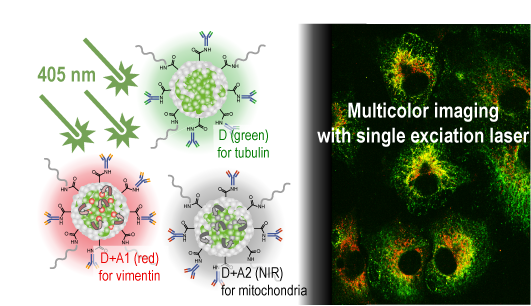
정지은 (제1저자)
We report newly synthesized fluorescence resonance energy transfer (FRET)-based green-, red-, and near-infrared (NIR)-emitting polymer dot (Pdot) probes. Fluorescent Pdots (∼60 nm) were prepared with a green-emissive conjugated polymer (PPDT-P, donor) alone or mixing the donor with a red- or NIR-emitting fluorophore (T-DCS or ITIC, acceptor), where an optically inert matrix polymer [poly(styrene-co-maleic anhydride)] was mixed together to minimize the aggregation-caused quenching by diluting the fluorophores and surface functionalization for further bioconjugation with antibodies for active targeting. Highly fluorescent green-emissive PPDT-P Pdots were prepared with a photoluminescence (PL) quantum efficiency of ∼30% and the FRET-mediated red and NIR PL was intensified by 5.3–8.5 times (with high FRET ratios of ∼9) via the efficient energy transfer (FRET efficiency of 80–98%) and antenna effect, compared with the signals obtained via direct excitation of the fluorophores in Pdots. All three types of Pdot/antibody conjugates were simultaneously immunostained to COS-7 cells (showing minimal cross-reactivity), reducing the tedious sequential immunostaining process to a single step. Finally, we obtained high-contrast three-color cell images with little spectral leakthrough by exciting all the probes simultaneously at a single wavelength at 405 nm without the need for a complicated or expensive multiple-excitation setup.

https://doi.org/10.1021/acs.chemmater.0c02172
 Multiply Charged Conjugated Polyelectrolytes as a Multifuncti...
Multiply Charged Conjugated Polyelectrolytes as a Multifuncti...
 Intermetallic PtCu Nanoframes as Efficient Oxygen Reduction E...
Intermetallic PtCu Nanoframes as Efficient Oxygen Reduction E...

















